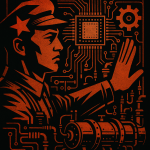Key Points
- Landmark Tech Merger: Haiguang Information (海光信息), a STAR Market chip designer, is undertaking a stock-swap absorption merger with Zhongke Shuguang (中科曙光), a Shanghai Main Board computing systems leader.
- First Under New Laws: This is the very first listed company-to-listed company absorption merger following China’s newly revised “Measures for the Administration of Material Asset Restructuring by Listed Companies,” effective May 16th.
- Strategic Synergy: The merger aims for vertical integration, combining Haiguang’s core chip design (CPUs/DCUs) expertise with Zhongke Shuguang’s strengths in high-performance computing and systems to create a stronger domestic tech ecosystem.
- Policy Encouragement: The deal aligns with recent Chinese policies like the “New Nine National Articles” and “Eight Sci-Tech Innovation Board Measures” that explicitly encourage such absorption mergers for industry consolidation.
- Rising M&A Activity: Since the “Eight Sci-Tech Innovation Board Measures,” the STAR Market has seen 102 new M&A transactions announced, totaling over ¥26 billion RMB, signifying a significant increase in strategic restructuring.

In a significant development for China’s tech sector, Haiguang Information (Haiguang Xinxi 海光信息) has just unveiled plans for a stock-swap merger with Zhongke Shuguang (Zhongke Shuguang 中科曙光), a move poised to reshape the domestic information industry.
This isn’t just any merger; it’s a big deal, folks.
Under this strategic transaction, Haiguang Information is set to issue A-shares (those are mainland China shares, for the uninitiated) to snap up all A-shares held by Zhongke Shuguang’s shareholders.
But wait, there’s more.
The plan also includes raising supporting funds by issuing even more A-shares.
To keep things fair, ensure transparent info disclosure, protect investor interests, and (wisely) avoid wild stock price swings, Haiguang Information’s A-shares will halt trading starting from the market open on May 26, 2025.
This trading suspension is expected to last no more than 10 trading days.
Breaking Down the Deal: Sci-Tech Star Haiguang Eyes Main Board Powerhouse Zhongke Shuguang
A “First” Following New M&A Rules
Hold onto your hats, because this is the very first listed company-to-listed company absorption merger after China’s “Measures for the Administration of Material Asset Restructuring by Listed Companies” got a fresh rewrite and was officially promulgated on May 16th.
Talk about moving fast!
On the evening of May 25th, both Haiguang Information (a Sci-Tech Innovation Board, or STAR Market, company) and Zhongke Shuguang (a Shanghai Main Board heavyweight) dropped the announcements.
The core plan: Haiguang Information will absorb and merge with Zhongke Shuguang by issuing its A-shares to all of Zhongke Shuguang’s A-share shareholders.
As mentioned, Haiguang also intends to raise supporting capital through an A-share issuance.
Both companies’ A-shares will pause trading from May 26th, for an estimated period of no more than 10 trading days.
This transaction is a trailblazer, marking the first absorption merger between listed companies since those revised restructuring measures hit the scene just days ago.

Resume Captain
Your AI Career Toolkit:
- AI Resume Optimization
- Custom Cover Letters
- LinkedIn Profile Boost
- Interview Question Prep
- Salary Negotiation Agent

Strategic Synergies: From Chips to Systems
So, why is this merger such a big deal for China’s information industry?
Well, both Zhongke Shuguang and Haiguang Information are leaders in their respective fields.
- Zhongke Shuguang brings deep expertise in high-performance computing (HPC), storage, and cloud computing.
- Haiguang Information is all about designing core chips, specifically domestic architecture CPUs (Central Processing Units) and DCUs (Data Center Processing Units).
The integration of these two powerhouses is set to optimize the industrial layout, bridging the gap from chips to software and systems.
Think of it as bringing together top-tier resources from both upstream (chip design) and downstream (system application) of the information industry chain.
This merger is expected to supercharge the leading role of these key enterprises, effectively “strengthening, supplementing, and extending” the entire industry chain.

What Industry Insiders Are Saying
Folks in the know believe this deal will significantly boost the brand influence of both companies and amplify the synergy of their combined strengths.
The strategic restructuring is all about achieving a deep integration of resources from these leading domestic information industry players.
Here’s what that means in practice:
- Combined R&D Prowess: They’ll pool their efforts in research and development.
- Supply Chain Optimization: Streamlining how they get things made and delivered.
- Expanded Sales Channels: Reaching more customers, more effectively.
The goal? To concentrate their core strengths and jointly invest in the R&D of high-end chips and solutions.
This should lead to more competitive, integrated technical solutions, ultimately improving customer satisfaction with their products and services.
The impact on shaping a mainstream universal computing ecosystem in China could be massive.
Furthermore, this merger is anticipated to create scale effects that will drive up profits.
It’s a classic case of quality improvement and efficiency enhancement.
Post-merger, the combined entity will boast a larger scale and broader business horizons.
Its technical strength and market competitiveness are expected to get a serious upgrade, laying a solid capital foundation for long-term growth.
Simply put, bigger scale often means better profits, allowing the listed company to level up its quality and efficiency.
The merger isn’t just about slapping two companies together.
It’s a strategic move to address existing shortcomings and build new strengths in China’s critical computing power industry.
With the global tech industry undergoing rapid transformation, this integration aligns perfectly with the trend of global industry_chain extension and development.
The expectation is that this will propel the combined entity to a higher level of development, fast.

Find Top Talent on China's Leading Networks
- Post Across China's Job Sites from $299 / role, or
- Hire Our Recruiting Pros from $799 / role
- Qualified Candidate Bundles
- Lower Hiring Costs by 80%+
- Expert Team Since 2014
Your First Job Post

Policy Tailwinds: M&A Activity Heats Up
New Rules Encourage Strategic Mergers
This Haiguang-Zhongke Shuguang deal isn’t happening in a vacuum.
Absorption mergers are precisely what current M&A and restructuring policies in China are encouraging.
Let’s look at the policy landscape:
- The New “Nine National Articles” (Xin “Guo Jiutiao” 新“国九条”) explicitly propose improving policies for absorption mergers. They encourage leading companies to consolidate upstream and downstream listed entities within their core business areas.
- The “Eight Sci-Tech Innovation Board Measures” (Kechuangban Batiao “科创板八条”) clearly support STAR Market-listed companies in focusing on strengthening their core businesses through absorption mergers.
- The “Six M&A Measures” (Binggou Liutiao “并购六条”) dive deeper, guiding leading listed companies to concentrate on their main business and ramp up integration of industry chain players. These measures also refine policies like share lock-up periods, supporting various absorption merger scenarios.
And then came the game-changer on May 16th: the revised “Measures for the Administration of Material Asset Restructuring by Listed Companies.”
These updated rules clarified lock-up period requirements for absorption mergers between listed companies and formally established a simplified review procedure.
Crucially, absorption mergers between listed companies are now listed as an applicable scenario for this streamlined process, further unlocking the potential for these types of deals.
- New “Nine National Articles” (Xin “Guo Jiutiao” 新“国九条”) – Encourage absorption mergers to consolidate upstream/downstream entities.
- “Eight Sci-Tech Innovation Board Measures” (Kechuangban Batiao “科创板八条”) – Support STAR Market companies focusing on core business via absorption mergers.
- “Six M&A Measures” (Binggou Liutiao “并购六条”) – Guide companies to focus on main business, integrate industry chain, refine lock-up periods.
- Revised “Measures for the Administration of Material Asset Restructuring by Listed Companies” (Effective May 16th) – Clarified lock-up, established simplified review for listed company absorption mergers.

ExpatInvest China
Grow Your RMB in China:
- Invest Your RMB Locally
- Buy & Sell Online in CN¥
- No Lock-In Periods
- English Service & Data
- Start with Only ¥1,000

Transaction Volume on the Rise
With all this policy momentum, market players are feeling more energized, and M&A activity, particularly on the Sci-Tech Innovation Board (STAR Market), has entered a new, exciting phase.
The numbers speak for themselves:
Since the release of the “Eight Sci-Tech Innovation Board Measures,” the STAR Market has seen 102 new M&A transactions announced.
The disclosed transaction amounts for these deals total over ¥26 billion RMB ($3.61 billion USD).
Zooming in on this year: since the beginning of 2025, 40 new M&A transactions have been disclosed on the STAR Market.
- 14 of these involve asset purchases via share or convertible bond issuance.
- 5 are significant cash restructurings.
Looking at the bigger picture, the number of significant cash acquisitions and share-issuance deals launched *after* the “Eight Sci-Tech Innovation Board Measures” came out has far exceeded the total number of such transactions in the entire five-year period from 2019 to 2023.
That’s a serious uptick in activity!
Companies that had previously announced plans are also making solid progress:
- Xinlian Jicheng (Xinlian Jicheng 芯联集成)‘s acquisition of Xinlian Yuezhou (Xinlian Yuezhou 芯联越zhou) has completed its audit inquiry response.
- Inquiries are out for deals like Silinjie (Silinjie 思林杰)‘s acquisition of Kekai Dianzi (Kekai Dianzi 科凯电子), and Jiabiyou (Jiabiyou 嘉必优)‘s acquisition of Ouyi Shengwu (Ouyi Shengwu 欧易生物).
- Others moving forward include Huahai Chengke (Huahai Chengke 华海诚科) with Hengsuo Huawei (Hengsuo Huawei 衡所华威), and Xidiwei (Xidiwei 希荻微) with Chengxinwei (Chengxinwei 诚芯微).
- Changyingtong (Changyingtong 长盈通)‘s acquisition of Shengyisheng Guangdian (Shengyisheng Guangdian 生一升光电) has been accepted for review.
- FPI (Hexin Yiqi 禾信仪器)‘s acquisition of Liangxi Jishu (Liangxi Jishu 量羲技术) and Bright Power Semiconductor (Jingfeng Mingyuan 晶丰明源)‘s acquisition of Injoinic Technology (Yichong Keji 易冲科技) have passed shareholder meetings and are awaiting reporting.
- SICC (Huigui Chanye 沪硅产业)‘s acquisition of minority stakes in three holding subsidiaries—Xinsheng Jingtou (Xinsheng Jingtou 新昇晶投), Xinsheng Jingke (Xinsheng Jingke 新昇晶科), and Xinsheng Jingrui (Xinsheng Jingrui 新昇晶睿)—has published its transaction draft.

Powering Up: Listed Companies Accelerate Full-Chain Integration
Thanks to these favorable policies, more Sci-Tech Innovation Board companies are getting creative, fully leveraging M&A and restructuring tools to achieve high-quality external growth.
We’re seeing a wave of M&A cases on the STAR Market that are all about building new quality productive forces and driving industrial integration.
Here are a few standout examples:
Yaxin Anquan Acquires Yaxin Keji: A Cybersecurity Consolidation
This was the first “A-share acquiring H-share” major asset restructuring on the Sci-Tech Innovation Board.
In November 2024, STAR Market-listed Yaxin Anquan (Yaxin Anquan 亚信安全) completed its acquisition of Hong Kong-listed Yaxin Keji (Yaxin Keji 亚信科技).
This deal became one of the largest acquisition transactions in China’s cybersecurity industry in 2024.
It’s also a noteworthy case of a listed company being acquired whose major shareholder is a private equity fund.
Through this move, Yaxin Anquan and Yaxin Keji are set for synergistic development in key info-infra sectors like telecom operators.
This helps Yaxin Anquan boost its capabilities, extend its product lines, strengthen its overall solution power, and improve asset quality and sustainable operations.
The impact? Yaxin Anquan’s 2024 annual report showed revenue of ¥3.595 billion RMB ($499 million USD), a whopping 123.56% year-on-year increase.
Meiai Keji Acquires Jiexinlong: Cleanroom Solutions Expansion
Another first: the “A-share acquiring H-share” privatization of a Hong Kong-listed company on the STAR Market.
In October 2024, STAR Market-listed Meiai Keji (Meiai Keji 美埃科技) announced its wholly-owned subsidiary acquired Hong Kong-listed Jiexinlong (Jiexinlong 捷芯隆) and took it private, using a mix of its own funds and M&A loans.
This transaction gives Meiai Keji the technical muscle and integration chops to independently offer customers comprehensive cleanroom solutions, from fan filter units to complete equipment and cleanroom systems.
It expands their market reach in cleanroom solutions and beefs up their product line.
The deal has been successfully completed.
NAURA Takes Control of Piotech: Integrating the IC Equipment Chain
And here’s the first “A-share controlling A-share” case in the integrated circuit (IC) industry chain on the Sci-Tech Innovation Board.
In March 2025, STAR Market-listed Piotech (Xinyuanwei 芯源微) and Shenzhen Main Board-listed NAURA Technology Group (Beifang Huachuang 北方华创) announced that NAURA is acquiring a 17.9% stake in Piotech via an agreement transfer and reorganizing Piotech’s board to gain control.
NAURA Technology Group is a leading domestic semiconductor equipment giant, with products covering core process equipment like etching, thin-film deposition, and thermal processing.
Piotech is a leader in domestic coating/developing equipment and single-wafer wet processing gear, with new products like chemical cleaning and temporary bonding also rapidly industrializing.
While both are in the IC equipment game, their product portfolios are different, making them highly complementary.
Post-transaction, they can push for process integration of different equipment through cooperation, synergistically offering customers more complete and efficient IC equipment solutions.
This Haiguang and Zhongke Shuguang merger, backed by supportive policies and a dynamic M&A market, is a clear signal of China’s push for a stronger, more integrated domestic tech industry, particularly in critical areas like semiconductors and high-performance computing.
References
- Haiguang Information: Plans to Absorb and Merge with Zhongke Shuguang via Stock Swap, Shares to Halt Trading Tomorrow – Cailian Press
- First Merger Following New Restructuring Rules! Sci-Tech Innovation Board’s Haiguang Information Plans to Absorb and Merge with Main Board’s Zhongke Shuguang – Shanghai Securities News
- Bombshell! Supporting Rules for “Six Acquisition Measures” and “Eight Sci-Tech Board Measures” Land, Five Key Points – Yicai Global

![Mind-Melds & Market Moves: The Brain-Computer Interface (BCI) Boom is Here [FreshFromChina]](https://freshfromchina.com/wp-content/uploads/2025/05/Mind_Melds_Market_Moves_The_BrainComputer_Interface_BCI_Boom_is_Here_TeamedUpChina-150x150.png)


![China's A-Shares Roar: Market Surges on PBOC Moves & Aerospace Boom – What Investors Need to Know [FreshFromChina]](https://freshfromchina.com/wp-content/uploads/2025/05/China_s_A-Shares_Roar__Market_Surges_on_PBOC_Moves___Aerospace_Boom__What_Investors_Need_to_Know____FreshFromChina-150x150.png)
